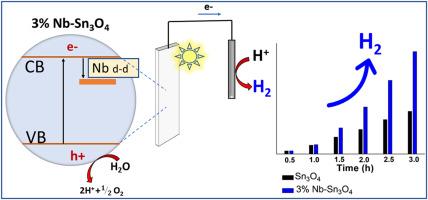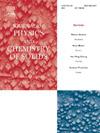Structural and optical investigation of Nb5+-doped Sn3O4 for photoelectrochemical hydrogen production
IF 4.3
3区 材料科学
Q2 CHEMISTRY, MULTIDISCIPLINARY
引用次数: 0
Abstract
We report herein, the microwave-assisted hydrothermal (MAH) synthesis of Nb5+-doped Sn3O4 nanoparticles for the photoelectrochemical production of hydrogen (H2). Nb5+ ions inside the Sn3O4 created structural defects, contributing to a local structural disorder, as confirmed by micro-Raman spectra. Photoluminescence spectroscopy indicated the decrease of the violet-blue–green visible emission after adding Nb5+, revealing the formation of alternative energy pathways for the electron/hole recombination. Through the morphological analysis, it was observed that the Nb5+ dopant slightly changed the morphology of nano-petals in Sn3O4. We demonstrate that the 3 % Nb5+ doped-Sn3O4 photoanode presented higher charge carrier mobility, higher photocurrent density, and an impressive H2 production of 1.50 mmol L−1 in a 3 h experiment, compared to the pure Sn3O4 material. The best performance of the Nb5+ doped Sn3O4 nanomaterial could be ascribed to the formation of new energy levels in the Sn3O4 band gap, thereby inhibiting the electron-hole pair recombination and positively affecting the photoelectrochemical response of the doped material.

用于光电化学制氢的掺杂 Nb5+ 的 Sn3O4 的结构和光学研究
我们在此报告微波辅助水热法(MAH)合成掺杂 Nb5+ 的 Sn3O4 纳米粒子,用于光电化学制氢(H2)。微拉曼光谱证实,Sn3O4 内部的 Nb5+ 离子造成了结构缺陷,导致局部结构紊乱。光致发光光谱表明,加入 Nb5+ 后,紫蓝绿色可见光发射减少,这揭示了电子/空穴重组的替代能量途径的形成。通过形态分析,我们发现掺杂 Nb5+ 会轻微改变 Sn3O4 中纳米金属的形态。我们证明,与纯 Sn3O4 材料相比,掺杂了 3% Nb5+ 的 Sn3O4 光阳极具有更高的电荷载流子迁移率、更高的光电流密度,并且在 3 小时的实验中产生了令人印象深刻的 1.50 mmol L-1 的 H2。掺杂 Nb5+ 的 Sn3O4 纳米材料的最佳性能可归因于在 Sn3O4 带隙中形成了新能级,从而抑制了电子-空穴对重组,并对掺杂材料的光电化学反应产生了积极影响。
本文章由计算机程序翻译,如有差异,请以英文原文为准。
求助全文
约1分钟内获得全文
求助全文
来源期刊
CiteScore
7.80
自引率
2.50%
发文量
605
审稿时长
40 days
期刊介绍:
The Journal of Physics and Chemistry of Solids is a well-established international medium for publication of archival research in condensed matter and materials sciences. Areas of interest broadly include experimental and theoretical research on electronic, magnetic, spectroscopic and structural properties as well as the statistical mechanics and thermodynamics of materials. The focus is on gaining physical and chemical insight into the properties and potential applications of condensed matter systems.
Within the broad scope of the journal, beyond regular contributions, the editors have identified submissions in the following areas of physics and chemistry of solids to be of special current interest to the journal:
Low-dimensional systems
Exotic states of quantum electron matter including topological phases
Energy conversion and storage
Interfaces, nanoparticles and catalysts.

 求助内容:
求助内容: 应助结果提醒方式:
应助结果提醒方式:


